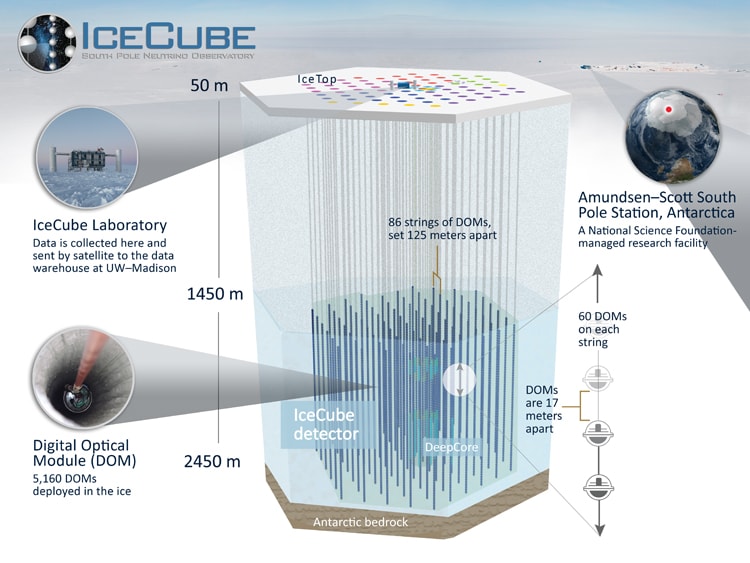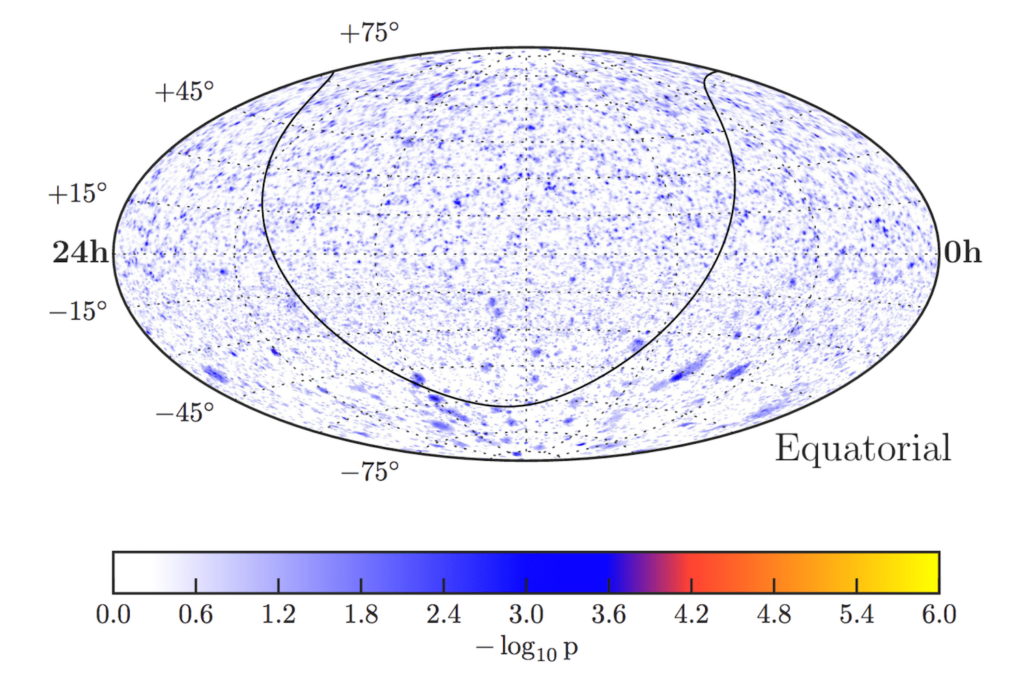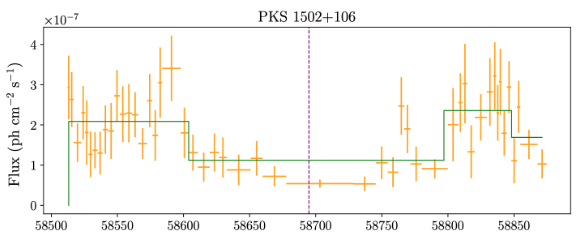Title: Searching for temporary gamma-ray dark blazars associated with IceCube neutrinos
Authors: E. Kun, I. Bartos, J. Becker Tjus, P. L. Biermann, A. Franckowiak, F. Halzen, and Gy. Mezo
First Author’s Institution:
Theoretical Physics IV: Plasma-Astroparticle Physics, Faculty for Physics & Astronomy, Ruhr University Bochum, 44780 Bochum, Germany
Status: Accepted to Astronomy & Astrophysics [open access]
Looking for the space ghost (particle)
There are a lot of astrophysical systems out there that are pretty extreme places, like active galactic nuclei, supernovae, gamma-ray bursts, fast radio bursts, among many others. Not only are these sources cool in their own right, but they can actually help us better understand the particles and their interactions that we see on Earth. Many of these systems are thought to be capable of shooting particles out to PeV energies (this is 100x more energetic than what state-of-the-art accelerators like the LHC can do!) and we actually detect cosmic rays (relativistic particles; usually protons or nuclei) up to PeV energies.
Today’s paper focuses on the astrophysical neutrino, which are a particularly cool (astro)particle (astroparticle means particles coming from space!) because they can both help trace the origin of other particles, like cosmic rays. Neutrinos have also long evaded detection, since they only interact through the weak force, which is, of course, weak. Neutrinos are often called the ghost particle because they just pass right through most matter undetected – like a ghost!
A really big IceCube to the rescue!

The IceCube neutrino observatory is a huge, cubic kilometre sized neutrino observatory located deep in the ice at the South Pole, as depicted in Figure 1. They first detected a high energy neutrino originating from outside of our solar system in 2013 (see this bite). This was the second ever neutrino found to be of astrophysical origin (the first was from supernova 1987A). Since then, IceCube has detected neutrino events from all over the sky (see Figure 2) with just one problem – we can’t confidently associate these neutrinos with any known photon emitting sources. Here, we’re looking for high energy photons, called gamma-rays, to match the energy of neutrinos that IceCube sees.
One of the currently accepted models for neutrino emission is that they come from highly energetic systems like blazars or supernovae and are produced alongside gamma-rays and cosmic rays in particle decay processes. Since cosmic rays are charged, they get shot off easily by galactic and extragalactic magnetic fields. This means we need to turn to gamma-rays and see if any are being detected at the same time as IceCube is detecting neutrinos– usually we look for anything emitting more gamma-rays than usual, called flaring. Since neutrinos don’t interact very often with other particles or with detectors, we also have to be looking for something that’s emitting a LOT of particles. This is because the more particles there are, the more likely it is that one will ultimately show up in IceCube’s detectors.

Today’s paper looks at the neutrino and gamma-ray relation from a new perspective. The authors suggest that there might be a reason that we don’t see gamma-ray flares when a source emits a neutrino. In fact, there may actually be fewer gamma-rays than usual. Looking at blazars, this comes from the idea that there can be changes in the environment near the blazar jet, where particles like gamma-rays and neutrinos are being accelerated. If there’s more gas and dust than usual, this is good for neutrino production. More particles hanging around means more collisions, so more neutrinos and photons can be made from scattering or decay.
That being said, short wavelength gamma-rays are easily scattered by surrounding clouds of gas and dust, because their wavelength is so close to the size of gas and dust particles. Neutrinos, on the other hand, are notoriously un-interactive with other particles. So, with this in mind, when things get cloudy near blazar jets, more gamma-rays and neutrinos are produced, but only neutrinos can make it out and start on their way toward our detectors on Earth.
Gamma-ray light, gamma-ray bright?, will we see a gamma-ray tonight?
The authors use data from the Fermi-LAT gamma-ray telescope to examine eight bright blazars that are in the same region as where IceCube has seen an astrophysical neutrino. The idea is to look at a six-month period before and after the neutrino detection to see if the source looks dimmer or brighter in gamma-rays than usual. Ideally, the sources would either all dim or all flare, which can help narrow down the conditions a blazar needs to satisfy to produce a neutrino.
Unfortunately, this search was inconclusive, and it looks like each blazar shows different behaviour around the time of the neutrino arrival. Some dim (see Figure 4), some brighten (see Figure 5), and some don’t change at all. This either means that each source shows different behaviour while it’s producing more neutrinos than usual, or that we don’t quite understand the environment where these particles are being produced and aren’t looking in the right places.


Much more coming soon!
But really, the golden age of astrophysical neutrinos is still just at the beginning! IceCube is getting a huge (literally) upgrade (called Gen 2 after gentoo penguins!) that will bring it to 8 km^3, increasing the number of detected neutrinos by a factor of ten being able to determine the location of neutrino sources much more accurately.
This is expected to come in 2032, shortly after the next generation of gamma-ray telescopes called the Cherenkov Telescope Array (CTA) comes online, which will be 5-10x more sensitive than current telescopes. This combination will open up the sky to many more high energy sources that we’ve never seen before, and hopefully solve some of the many astroparticle mysteries that we’re scratching our heads about today!
Astrobite edited by Evan Lewis
Featured image credit: IceCube/NASA

Lots of differences among what initially looked like different high energy astronomical objects turned out to (most likely) be due to different viewing angles. Could this be another one?
Kind of! Blazars are one of these objects – they’re thought to be supermassive black holes with their jets pointed toward Earth. We think that there may be some clouds of gas and dust near the jets that are able to move and block out gamma-rays that can move around so that sometimes they’re in the way and sometimes they’re not. There’s still a LOT about blazar jets and their environments that we don’t understand, so neutrinos can hopefully help solve some of these mysteries!